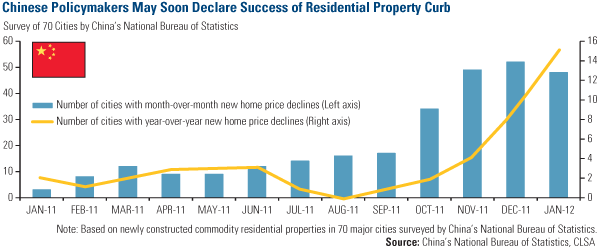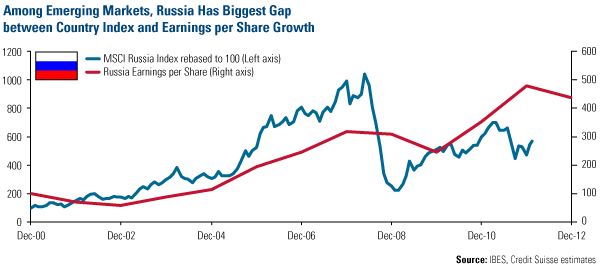Emerging Markets Radar (February 27, 2012)
Strengths
- To spur lending, China cut the amount of cash that banks must set aside as reserves for the second time in three months. Reserve requirements will fall by 50 basis points effective February 24, the People’s Bank of China stated on its website, freeing up approximately RMB 400 billion. Experts have found out that China will further cut reserve rate depending on the direction of the Purchasing Manager’s Index (PMI) and Consumer Price Index (CPI). The required reserve ratio is lowered to 20.5 percent for large banks and 18.5 percent for medium and small banks.
- China’s Central Huijin aims to be an active investor in institutions it takes holdings in and ensure the smooth development of those companies, the official Xinhua News Agency reported on Tuesday.
- The China HSBC Flash PMI is 49.7 for February, improving 9 basis points from 48.8 in January.
- Xiangshan County in China’s eastern province of Zhejiang canceled restrictions on buying homes starting this year, National Business Daily reports, citing an unidentified source from the local property industry. Just last week Shanghai Securities News reported that Shanghai had eased some restrictions, and subsequently the city denied it was a new measure, claiming that it had always been on the books. This is the pattern in China now where the local governments don’t like the headline news saying they have relaxed housing curbs.
- Poland sold a further stake in the country’s largest power utility, raising the most from asset sales in eight months to help finance the budget deficit. The budget deficit in 2011 was 25.1 billion zloty, much lower than the projected 40.2 billion, due to lower government spending and higher revenues.
- Malaysia’s inflation appears to have peaked, with the CPI falling slightly to 2.7 percent year-over-year in January from 3 percent in December. RGE Monitor is predicting that slow GDP and demand growth will keep inflation subdued throughout 2012, despite higher food prices.
Weaknesses
- China’s January home prices recorded their worst performance in at least a year, with none of the 70 cities monitored by the government posting gains, as Premier Wen Jiabao reiterated his determination to maintain property curbs. Nevertheless, the market expects the government to relax curbs in some ways after Liang Hui, the two annual congressional conferences.
- Thailand’s fourth quarter GDP shrank 9 percent, the first contraction in more than two years. The median Bloomberg estimate was for a decline of 5 percent, due the flooding last fall. However, this is one-off event and the country is in the process of recovery.
- Taiwan’s fourth quarter GDP was up 1.89 percent, closely in line with the estimated 1.9 percent.
- Singapore’s industrial production declined 8.8 percent in January, falling the most in eight months due to reduced electronics demand and overall lunar New Year effects.
- Liquidity measures announced by the Hungarian central bank are aimed at alleviating the ongoing credit. The two-year lending facility will provide support for sovereign debt prices, but RGE Monitor expects only limited pass-through to household and corporate credit due to higher risk aversion and sluggish growth.
- According to Brazil’s monthly activity indicator, the economy grew 2.7 percent year-over-year in 2011, short of Roubini’s 3 percent forecast. This can be attributed to the combination of Brazil’s business cycle, tighter macroeconomic conditions (both fiscal and monetary) and a depressed global economy, which has made the deceleration much sharper than originally expected.
Opportunities
- McKinsey Global Institute highlighted in its latest quarterly piece that in order for Vietnam to continue on a strong GDP growth trajectory, the country faces a number of challenges. According to official Vietnam statistics, growth in the country’s labor force will probably decline to about 0.6 percent per year over the next decade, down from 2.8 percent between 2000 and 2010. The larger challenge long-term for the country is that the robust growth, which stemmed in the past from a young, growing labor force and the transition from agriculture to manufacturing and services, will be challenged as Vietnam needs new sources of growth to replace them. The demographic tailwind responsible for driving a third of Vietnam’s past growth is slackening. Some companies already report labor shortages in major cities, and by 2020, the share of the population aged 5 to 19 is projected to drop to 22 percent, from 27 percent in 2010 and 34 percent in 1999.
- South Africa will report fourth quarter GDP on February 28. Stronger output data in the fourth quarter suggests that growth expanded by 3.1 percent in 2011 overall, driven mainly by domestic demand.
- The chart below shows an increasing number of cities that see home prices declining. Many believe declining home prices are the triggers for the Chinese central government to ease the housing restrictions.

- While earnings for 2012 are estimated to be 37 percent higher than they were in 2007, the Russian equity index is 25 percent below the 2007 level - the largest gap among emerging markets.

Threats
- As of February 20, big 4 banks’ new deposit in February was CNY 310 billion, 150 billion lower than that of February 10, which indicates a cash outflow at banks in the past ten days which is causing tight liquidity.
- Riding a populist wave, Russian Prime Minister Vladimir Putin suggested that rising loan rates are fanning inflation and ordered his finance minister to intervene. VTB’s CEO Andrey Kostin responded through an article in the Financial Times stating that without additional liquidity from the central bank, VTB will stop increasing its loan book.











